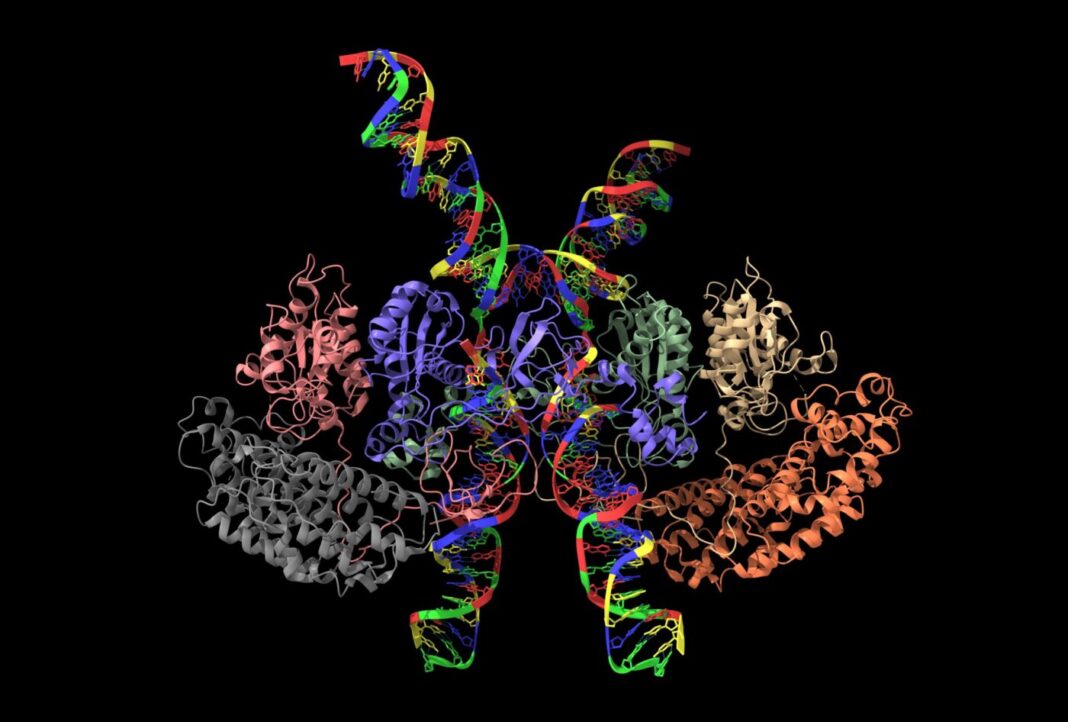Using advanced imaging technology, Mayo Clinic scientists have provided a better understanding of the BRCA1-BARD1 protein complex, which is often mutated in patients with breast or ovarian cancer. Their paper (“Mechanisms of BRCA1–BARD1 nucleosome recognition and ubiquitylation”), published in Nature, identifies aspects of how BRCA1-BARD1 functions, supporting future translational research, cancer prevention efforts and drug development.
“The BRCA1–BARD1 tumor suppressor is an E3 ubiquitin ligase necessary for the repair of DNA double-strand breaks by homologous recombination. The BRCA1–BARD1 complex localizes to damaged chromatin after DNA replication and catalyzes the ubiquitylation of histone H2A and other cellular targets. The molecular bases for the recruitment to double-strand breaks and target recognition of BRCA1–BARD1 remain unknown,” write the investigators.
“Here we use cryo-electron microscopy to show that the ankyrin repeat and tandem BRCT domains in BARD1 adopt a compact fold and bind to nucleosomal histones, DNA and monoubiquitin attached to H2A amino-terminal K13 or K15, two signals known to be specific for double-strand breaks. We further show that RING domains in BRCA1–BARD1 orient an E2 ubiquitin-conjugating enzyme atop the nucleosome in a dynamic conformation, primed for ubiquitin transfer to the flexible carboxy-terminal tails of H2A and variant H2AX.
“Our work reveals a regulatory crosstalk in which recognition of monoubiquitin by BRCA1–BARD1 at the N terminus of H2A blocks the formation of polyubiquitin chains and cooperatively promotes ubiquitylation at the C terminus of H2A. These findings elucidate the mechanisms of BRCA1–BARD1 chromatin recruitment and ubiquitylation specificity, highlight key functions of BARD1 in both processes and explain how BRCA1–BARD1 promotes homologous recombination by opposing the DNA repair protein 53BP1 in post-replicative chromatin.
“These data provide a structural framework to evaluate BARD1 variants and help to identify mutations that drive the development of cancer.”
“BRCA1-BARD1 is important for DNA repair. It has direct relevance to cancer because hundreds of mutations in the BRCA1 and BARD1 genes have been identified in cancer patients,” says Georges Mer, PhD, a Mayo Clinic structural biologist and biochemist who is the lead author of the paper. “But no one knows if these mutations, or variants of unknown significance, are cancer-predisposing or not because we do not know whether the variants are located in a region of BRCA1-BARD1 that is important for function. Now because we can see how BRCA1-BARD1 works, we have a good idea of what regions of BRCA1-BARD1 are important for function.”
DNA and histone protein complex
In a cell, the complex of DNA and histone proteins are complexed into chromatin and packaged into nucleosomes. DNA damage response proteins need to access chromatin to repair damaged DNA. BRCA1-BARD1 contributes to fixing broken DNA strands, which helps in the maintenance and survival of cells. But it is also a function that could possibly be blocked or inactivated if this is a strategy a cancer cell uses to survive chemotherapy.
“We used two techniques―cryo-electron microscopy and nuclear magnetic resonance spectroscopy―to understand at near-atomic resolution how BRCA1-BARD1 associates with the nucleosome, the repeating unit of chromatin, and how BRCA1-BARD1 modifies chromatin,” explains Mer.
In cryo-electron microscopy, purified BRCA1-BARD1 bound to nucleosomes, together referred to as macromolecules, are flash-frozen then imaged using an electron microscope. The macromolecules are oriented in various ways within the sample, so a computer program evaluates all the orientation data to create a 3D structure. Mer and his team also examined BRCA1-BARD1 nucleosome complexes with nuclear magnetic resonance spectroscopy, which uses a strong magnet to probe the relative positions of atoms within macromolecules. Using these imaging tools, the scientists could visualize BRCA1-BARD1 in action and uncover a new function of the complex.
“We showed how BRCA1-BARD1 attaches ubiquitin to the nucleosome, but we also determined that BRCA1-BARD1 recognizes ubiquitin already attached to the nucleosome, which serves as a signal for broken DNA,” says Mer. “We discovered an unexpected cross-talk by which ubiquitin recognition by BRCA1-BARD1 enhances its ubiquitin attachment activity, and this helps us better understand how BRCA1-BARD1 performs its function.”
The researchers created a video from the cryo-electron microscopy data to show where the protein complex interacts with the nucleosome.
Mer and his team expect that high-resolution images of BRCA1-BARD1 can help guide patient care and future treatment of cancer in two ways: classifying variants of unknown significance and directing drug development with more accuracy.
“With these 3D structures, we should be able to convert several variants of unknown significance to likely cancer-predisposing variants,” says Mer. “This work is also expected to have an impact on drug development in the long term because the 3D structures of BRCA1-BARD1 in complex with the nucleosome we generated may help in the design of small molecules that could, for example, inactivate BRCA1-BARD1.”


